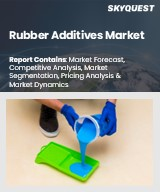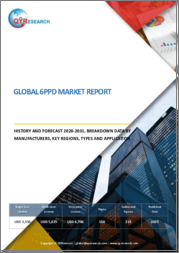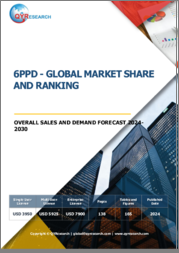
|
시장보고서
상품코드
1557359
세계의 고무 첨가제 시장 : 예측(2024-2029년)Rubber Additives Market - Forecasts from 2024 to 2029 |
||||||
고무 첨가제 시장은 예측 기간 동안 CAGR 4.33%로 성장할 전망이며, 2024년 59억 7,700만 달러에서 2029년에는 73억 2,000만 달러에 이를 것으로 예측됩니다.
첨가제에는 가황 공정, 충전제, 촉진제 및 기타 재료가 포함되어 가공성 향상, 가교 촉진 및 촉진, 완성 고무 제품의 특성 향상을 위해 사용됩니다. 성장하는 자동차산업, 제조업, 전기절연산업 등 다양한 산업에서 고무 폴리머 소비 증가가 세계의 고무 첨가제 시장을 견인하고 있습니다. 또한 고무를 타이어 이외의 용도로 사용하는 것도 시장 성장에 큰 영향을 미칩니다. 그러나 세계적으로 필요한 당국의 엄격한 규제와 정책은 시장 성장을 방해하고 있습니다. 지리적으로 아시아태평양은 세계의 고무 첨가제 시장을 견인할 것으로 예상되며, 특히 인도나 중국과 같은 국가에서 급속한 산업화로 인한 다양한 최종 이용 산업의 확대가 그 이유입니다. 마찬가지로 유럽은 독일의 자동차 시장 확대로 인해 큰 시장 성장이 예상됩니다.
고무 첨가제 시장 성장 촉진요인 :
- 타이어 및 고무 산업에 있어서 수요의 고조
스티렌 부타디엔 고무 및 부타디엔 고무와 같은 합성 고무의 조합을 포함하는 고무 첨가제는 타이어 제조에 널리 사용됩니다. 이러한 고무 첨가제의 사용은 고품질 타이어의 제조를 지원하기 때문에 타이어 산업의 성장을 가져오고 수요를 증가시킵니다. 게다가 빅데이터 도입 증가와 디바이스의 자동화 수요 증가도 시장의 성장을 뒷받침하고 있습니다.
미국 타이어 공업회에 따르면 2021년 시점에서 미국의 타이어 총 출하량은 2019년 3억 3,270만개에서 2021년에는 3억 3,520만개로 증가하고, 2022년에는 3억 4,020만개 도달합니다. 게다가 2021년에 비해 승용차용 타이어, 소형 트럭용 타이어, 트럭용 타이어의 OE(Original Equipment) 출하량이 각각 6.2%, 4.4%, 6.3% 증가하여 총 290만개 증가가 전망됩니다.
- 인프라 및 건설 업계 수요 증가
세계 인프라 정비의 급속한 확대도 고무 첨가제 시장의 주요 촉진요인입니다. 정부 및 민간 부문은 도시화와 경제 성장을 지원하기 위해 도로, 다리, 공항 등의 교통망을 구축하고 개선하는 데 많은 투자를 하고 있습니다. 이러한 점에서 이러한 고무 첨가제는 건물의 방수성을 확보하고 에너지 효율이 높기 때문에 환경 파괴로부터 보호하기 위해 효율적으로 사용됩니다.
아시아개발은행에 의하면 개발도상 아시아가 효율적으로 성장하고 기후 변화에 대한 효과적인 대응과 빈곤에 대처하면서 성장세를 유지하기 위해서는 2030년까지 연간 1조 7,000억 달러를 인프라에 투자해야 합니다. 또한 도시가 확대되고 인프라 프로젝트가 증가함에 따라 결과는 장수명과 구조적 무결성을 보장하는 데 필수적인 요소인 고무 첨가제와 같은 건축자재 증가와 직결됩니다. 또한 현대의 엔지니어링 프로젝트는 복잡성이 커지므로 엄격한 안전 및 성능 기준을 충족할 수 있는 고무 첨가제를 효율적으로 사용해야 합니다. 이 동향은 급속한 도시화가 진행되는 신흥 경제국에서 특히 두드러지며 혁신적인 건설 솔루션의 필요성을 더욱 높여 고무 첨가제 시장을 전진시키고 있습니다.
고무 첨가제 시장의 지리적 전망
예측 기간 동안 고무 첨가제 시장의 성장은 유럽의 기여를 기대합니다.
독일과 영국과 같은 주요 경제국들이 유럽의 고무 첨가제 시장을 성장시킬 것으로 예상됩니다. US News &World Report에 따르면 인프라가 가장 발달하고 있는 것은 독일이며 미국이 이에 이릅니다. Global Infrastructure Hub 2024에 따르면 독일 인프라 투자는 다양한 분야로 세분화되어 있으며, 예를 들어 운송 분야는 연간 203억 3,600만 달러로 인프라 투자 전체의 51%를 차지하고, 그 다음으로 재생가능 발전이 연간 58억 4,600만 달러로 15%를 차지합니다. 또한 독일 연방 정부의 중요한 교통 인프라 계획 도구인 2030년 연방 교통 인프라 계획(FTIP)도 고무 첨가제 시장 성장을 위한 효과적인 단계입니다. 이것은 주로 이 계획이 도로, 철도, 수로의 각 모드의 업그레이드나 신규 건설 프로젝트의 추가를 향한 한 걸음이기 때문입니다.
고무 첨가제 시장 성장 억제요인 :
- 고무화학물질에 대한 환경제약은 고무첨가제 시장의 성장을 방해하는 억제요인으로 작용합니다.
고무 첨가제 시장을 유형별로 분류하면 촉진제, 열화 방지제, 가황제, 점착 부여제 등으로 나눌 수 있습니다.
고무 첨가제는 촉진제와 열화 방지제로 크게 나뉘어 자동차 산업과 건설 산업에서 널리 사용됩니다. 아시아와 아프리카의 경제 성장과 함께 고무 첨가제 수요는 최종 사용자 산업의 성장과 함께 시장 성장을 견인합니다.
고무 첨가제 시장의 주요 발전 :
- 2023년 2월 : Yokohama Rubber Group은 2021년도부터 2023년도까지의 신중기 경영 계획 「Yokohama Transformation 2023」을 스타트했습니다. 이 프로젝트는 인도의 생산 타이어 능력을 확대하기 위한 한 걸음으로, 그룹 생산량은 60% 증가합니다.
- 2022년 7월 : Berch Chemicals는 아시아 시장 수요 증가에 대응하기 위해 새로운 기업을 설립했습니다. 경화 활성제 및 건조제는 기업의 제품에 포함됩니다. 게다가 2023년 10월에는 200년 이상의 역사를 가진 싱글톤 버치 그룹의 일원인 버치 케미컬즈가 첨가제 공급을 개시합니다.
- 2022년 6월 : Evonik's Coating & Adhesive Resiin 사업 라인과 POLYVEST eCO는 지속 가능한 액상 폴리부타디엔의 새로운 시리즈를 출시했습니다. 이 혁신적인 제품 라인의 제조에 이 지속 가능한 방식으로 생산된 부타디엔을 사용함으로써 ISCC 인증과 함께 화석 원료의 사용을 최대 99.9% 줄일 수 있습니다.
고무 첨가제 시장은 다음과 같이 세분화되고 분석됩니다.
유형별
- 촉진제
- 분해방지제
- 가황제
- 점착제
- 기타
용도별
- 타이어 이외
- 타이어
지역별
- 북미
- 미국
- 캐나다
- 멕시코
- 남미
- 브라질
- 아르헨티나
- 기타 남미
- 유럽
- 영국
- 독일
- 프랑스
- 이탈리아
- 스페인
- 기타 유럽
- 중동 및 아프리카
- 사우디아라비아
- UAE
- 기타 중동 및 아프리카
- 아시아태평양
- 중국
- 인도
- 일본
- 한국
- 대만
- 태국
- 인도네시아
- 기타 아시아태평양
목차
제1장 서론
- 시장 개요
- 시장의 정의
- 조사 범위
- 시장 세분화
- 통화
- 전제조건
- 기준년 및 예측년의 타임라인
- 이해 관계자에게 있어서의 주요 이점
제2장 조사 방법
- 조사 디자인
- 조사 과정
제3장 주요 요약
- 주요 조사 결과
- 애널리스트 보기
제4장 시장 역학
- 시장 성장 촉진요인
- 타이어 및 고무 산업의 성장
- 건설 업계로부터 수요 증가
- 시장 성장 억제요인
- 고무화학약품에 관한 환경제약
- 대체품으로부터의 위협
- Porter's Five Forces 분석
- 업계 밸류체인 분석
제5장 고무 첨가제 시장 : 유형별
- 서문
- 가속기
- 열화 방지제
- 가황
- 점착제
- 기타
제6장 고무 첨가제 시장 : 용도별
- 서문
- 타이어 없음
- 타이어
제7장 고무 첨가제 시장 : 지역별
- 세계 개요
- 북미
- 미국
- 캐나다
- 멕시코
- 남미
- 브라질
- 아르헨티나
- 기타 남미
- 유럽
- 영국
- 독일
- 프랑스
- 이탈리아
- 스페인
- 기타 유럽
- 중동 및 아프리카
- 사우디아라비아
- 아랍에미리트(UAE)
- 기타 중동 및 아프리카
- 아시아태평양
- 중국
- 인도
- 일본
- 한국
- 대만
- 태국
- 인도네시아
- 기타 아시아태평양
제8장 경쟁 환경 및 분석
- 주요 기업 및 전략 분석
- 시장 점유율 분석
- 합병, 인수, 합의 및 협업
- 경쟁 대시보드
제9장 기업 프로파일
- Emery Oleochemical
- Behn Meyer
- Akzo Nobel NV
- King Industries, Inc
- Thomas Swan & Co. Ltd.
- Eastman Chemical Company
- BASF SE
The rubber additives market is expected to grow at a CAGR of 4.33% during the forecast period, reaching US$7.320 billion in 2029 from US$5.977 billion in 2024.
Additives can include vulcanization processes, fillers, accelerators, and other materials and are used to enhance processability, facilitate or accelerate cross-linking, or improve the finished rubber product properties. The increasing consumption of rubber polymers from various industries, such as the growing automotive, manufacturing, and electrical insulation industries, drives the global rubber additives market. Moreover, using rubber in non-tire applications also significantly impacts the market growth. However, stringent regulations and policies from necessary authorities worldwide impair market growth. Geographically, the Asia Pacific region is expected to drive the global market of rubber additives on account of the expansion of various end-use industries owing to rapid industrialization, especially in countries like India and China. Similarly, Europe is estimated to have significant market growth due to the expansion of the automobile market in Germany.
RUBBER ADDITIVES MARKET DRIVERS:
- Rising demand in the tire and rubber industry
Rubber additives, including combinations of synthetic rubbers like styrene-butadiene rubber and butadiene rubber, are used widely in tire manufacturing. This usage of rubber additives will result in the growth of the tire industry as it will support the manufacturing of high-quality tires, thus increasing their demand. Furthermore, an increase in big data adoption and the increasing demand for device automation are also boosting the market's growth.
According to the U.S. Tire Manufacturers Association, as of 2021, the total tire shipments in the United States increased from 332.7 million units in 2019 to 335.2 million units in 2021, reaching 340.2 million units in 2022. Furthermore, compared to 2021, there was an expected increase in the Original Equipment (OE) shipments for passenger, light trucks, and truck tires, constituting 6.2%, 4.4%, and 6.3%, respectively, resulting in a total of 2.9 million units.
- Growing demand from the infrastructure and construction industry
The rapid expansion of infrastructure development globally is another primary driver for the rubber additives market. Governments and private sectors invest heavily in building and upgrading transportation networks, including roads, bridges, and airports, to support urbanization and economic growth. These rubber additives, in this regard, are used efficiently to ensure that buildings remain watertight and are protected from environmental damage because they are energy-efficient.
According to the Asian Development Bank, there is a need for developing Asia to invest $1.7 trillion per year in infrastructure until 2030 to grow efficiently and maintain its growth momentum while effectively responding to climate change and tackling poverty. Additionally, as cities expand and there is growth in infrastructure projects, the results will directly correlate with the growth of construction materials like rubber additives, which are essential components ensuring longevity and structural integrity. Moreover, the increasing complexity of modern engineering projects necessitates the efficient use of rubber additives that can meet stringent safety and performance standards. This trend is particularly pronounced in emerging economies where rapid urbanization occurs, further driving the need for innovative construction solutions and propelling the rubber additives market forward.
Rubber Additives Market Geographical Outlook
The European region is expected to contribute to the rubber additives market's growth during the forecast period.
The major economies like Germany and the United Kingdom are expected to grow the European region rubber additives market. According to U.S. News & World Report, Germany has the most developed infrastructure, followed by the United States. According to the Global Infrastructure Hub 2024, Germany's infrastructure investment is segmented into different sectors, such as the transportation sector constituting 51% of total investment in infrastructure with an annual rate of US$20,336 million, followed by the renewable generation with 15% at an annual rate of 5,846 million. Moreover, the Federal Government's imperative transport infrastructure planning tool, the 2030 Federal Transport Infrastructure Plan (FTIP) of Germany, is also an effective step towards the rubber additives market's growth. This is mainly because this plan is a step towards upgrading and adding new construction projects for the road, rail, and waterway modes.
Rubber additives market restraints:
- Environmental constraints about rubber chemicals will act as a restraining factor that will hamper the rubber additives market's growth.
The rubber additives market by type is segmented into accelerators, anti-degradants, vulcanization, tackifiers, and others.
The rubber additives are broadly segmented into accelerators and anti-degradants and are widely used in the automotive and construction industries. With the growing economies of Asia and Africa, the demand for rubber additives will drive market growth, along with growth in the end-user industries.
Rubber additives market key developments:
- In February 2023, The Yokohama Rubber Group through the fiscal year 2021 through the fiscal year 2023, moved forward with the launch of its new medium-term management plans, which is known as the Yokohama Transformation 2023, which will be an essential plan guiding the path for three years. This project is a step towards expanding India's production tire capacity, which will increase the group's production by 60%.
- In July 2022, Birch Chemicals established a new entity to meet the growing demand in the Asian market. Curing activators and desiccants are among the company's products. Furthermore, in October 2023, Birch Chemicals, which is part of the Singleton Birch Group that has been operating for over 200 years, will start supplying additives.
- In June 2022, Evonik's Coating & Adhesive Resiin business line with POLYVEST eCO launched a new range of sustainable liquid polybutadienes. The use of these sustainably produced butadiene in the manufacture of this innovative product line, along with the ISCC certification, reduces the use of fossil raw materials by up to 99.9%.
The rubber additives market is segmented and analyzed as follows:
By Type
- Accelerators
- Antidegradants
- Vulcanization
- Tackifiers
- Others
By Application
- Non-Tire
- Tire
By Geography
- North America
- USA
- Canada
- Mexico
- South America
- Brazil
- Argentina
- Rest of South America
- Europe
- United Kingdom
- Germany
- France
- Italy
- Spain
- Rest of Europe
- Middle East and Africa
- Saudi Arabia
- UAE
- Rest of the Middle East and Africa
- Asia Pacific
- China
- India
- Japan
- South Korea
- Taiwan
- Thailand
- Indonesia
- Rest of Asia-Pacific
TABLE OF CONTENTS
1. INTRODUCTION
- 1.1. Market Overview
- 1.2. Market Definition
- 1.3. Scope of the Study
- 1.4. Market Segmentation
- 1.5. Currency
- 1.6. Assumptions
- 1.7. Base and Forecast Years Timeline
- 1.8. Key benefits for the stakeholders
2. RESEARCH METHODOLOGY
- 2.1. Research Design
- 2.2. Research Process
3. EXECUTIVE SUMMARY
- 3.1. Key Findings
- 3.2. Analyst View
4. MARKET DYNAMICS
- 4.1. Market Drivers
- 4.1.1. Growth in the Tire and Rubber Industry
- 4.1.2. Growing Demand from the Construction Industry
- 4.2. Market Restraints
- 4.2.1. Environmental Constraints Pertaining to Rubber Chemicals
- 4.2.2. Threats from Substitutes
- 4.3. Porter's Five Forces Analysis
- 4.3.1. Bargaining Power of Suppliers
- 4.3.2. Bargaining Power of Buyers
- 4.3.3. The Threat of New Entrants
- 4.3.4. Threat of Substitutes
- 4.3.5. Competitive Rivalry in the Industry
- 4.4. Industry Value Chain Analysis
5. RUBBER ADDITIVES MARKET BY TYPE
- 5.1. Introduction
- 5.2. Accelerators
- 5.3. Antidegradants
- 5.4. Vulcanization
- 5.5. Tackifiers
- 5.6. Others
6. RUBBER ADDITIVES MARKET BY APPLICATION
- 6.1. Introduction
- 6.2. Non-Tire
- 6.3. Tire
7. RUBBER ADDITIVES MARKET BY GEOGRAPHY
- 7.1. Global Overview
- 7.2. North America
- 7.2.1. United States
- 7.2.2. Canada
- 7.2.3. Mexico
- 7.3. South America
- 7.3.1. Brazil
- 7.3.2. Argentina
- 7.3.3. Rest of South America
- 7.4. Europe
- 7.4.1. United Kingdom
- 7.4.2. Germany
- 7.4.3. France
- 7.4.4. Italy
- 7.4.5. Spain
- 7.4.6. Rest of Europe
- 7.5. Middle East and Africa
- 7.5.1. Saudi Arabia
- 7.5.2. United Arab Emirates
- 7.5.3. Rest of the Middle East and Africa
- 7.6. Asia-Pacific
- 7.6.1. China
- 7.6.2. India
- 7.6.3. Japan
- 7.6.4. South Korea
- 7.6.5. Taiwan
- 7.6.6. Thailand
- 7.6.7. Indonesia
- 7.6.8. Rest of Asia-Pacific
8. COMPETITIVE ENVIRONMENT AND ANALYSIS
- 8.1. Major Players and Strategy Analysis
- 8.2. Market Share Analysis
- 8.3. Mergers, Acquisitions, Agreements, and Collaborations
- 8.4. Competitive Dashboard
9. COMPANY PROFILES
- 9.1. Emery Oleochemical
- 9.2. Behn Meyer
- 9.3. Akzo Nobel N.V
- 9.4. King Industries, Inc
- 9.5. Thomas Swan & Co. Ltd.
- 9.6. Eastman Chemical Company
- 9.7. BASF SE



















